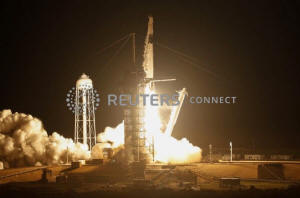|
SpaceX rocket with unmanned U.S. capsule
blasts off for space station
 Send a link to a friend
Send a link to a friend
 [March 02, 2019]
By Joey Roulette [March 02, 2019]
By Joey Roulette
CAPE CANAVERAL, Fla. (Reuters) - A SpaceX
rocket with an unmanned crew capsule blasted off on Saturday for the
International Space Station, in a key milestone for Elon Musk's space
company and NASA's long-delayed goal to resume human spaceflight from
U.S. soil later this year.
SpaceX's 16-foot-tall (4.9 meter) Crew Dragon capsule, atop a Falcon 9
rocket, lifted off from Florida's Kennedy Space Center at 2:49 a.m.
(0749 GMT), carrying a test dummy nicknamed Ripley.
The capsule successfully separated from the rocket about 11 minutes
later, sparking cheers in the control room, and began its journey to the
space station.

"I almost thought we would fail. I thought maybe we'd have a 10 percent
chance of reaching orbit starting out," Silicon Valley billionaire Musk
said of his feelings when he founded the space company in 2002.
"I'm a little emotionally exhausted because that was super stressful,
but it worked," he told reporters after Saturday's launch.
The space station's three-member crew was expected to greet the capsule,
carrying 400 pounds (181 kg) of supplies and test equipment, early
Sunday morning, NASA said.
During its five-day stay, U.S. astronaut Anne McClain and Canadian
astronaut David Saint-Jacques will run tests and inspect Crew Dragon's
cabin.
NASA has awarded SpaceX and Boeing Co $6.8 billion to build competing
rocket and capsule systems to launch astronauts into orbit from American
soil for the first time since the U.S. Space Shuttle was retired from
service in 2011.
Either SpaceX or Boeing will have bragging rights as the first private
company to launch humans into space on its own rocket, although plans
call for rockets built by both companies to carry astronauts into space.
[to top of second column]
|

A SpaceX Falcon 9 rocket, carrying the Crew Dragon spacecraft, lifts
off on an uncrewed test flight to the International Space Station
from the Kennedy Space Center in Cape Canaveral, Florida, U.S.,
March 2, 2019. REUTERS/Mike Blake

The launch systems are aimed at ending U.S. reliance on Russian
rockets for rides to the $100 billion orbital research laboratory,
which flies about 250 miles (400 km) above Earth, at about $80
million per ticket.
While Saturday's SpaceX test mission is a crucial step in the
oft-delayed project, there are questions about whether NASA can
achieve its 2019 flight goal of manned flight.
Reuters reported on Feb. 21 that SpaceX and Boeing both must address
significant design and safety concerns before they can fly humans.
Early on Friday, Musk, who is also chief executive officer of
electric carmaker Tesla Inc, tweeted a photo of the inside of Crew
Dragon capsule with Ripley strapped inside.
SpaceX said the spacesuit for Ripley, apparently a reference to the
protagonist in the science fiction movie "Alien", has been embedded
with sensors around its head, neck, and spine to monitor how a
flight would feel for a human.
(Reporting by Joey Roulette in Cape Canaveral; Editing by David
Gregorio, Kim Coghill and Ros Russell)
[© 2019 Thomson Reuters. All rights
reserved.]
Copyright 2019 Reuters. All rights reserved. This material may not be published,
broadcast, rewritten or redistributed.
Thompson Reuters is solely responsible for this content.
 |